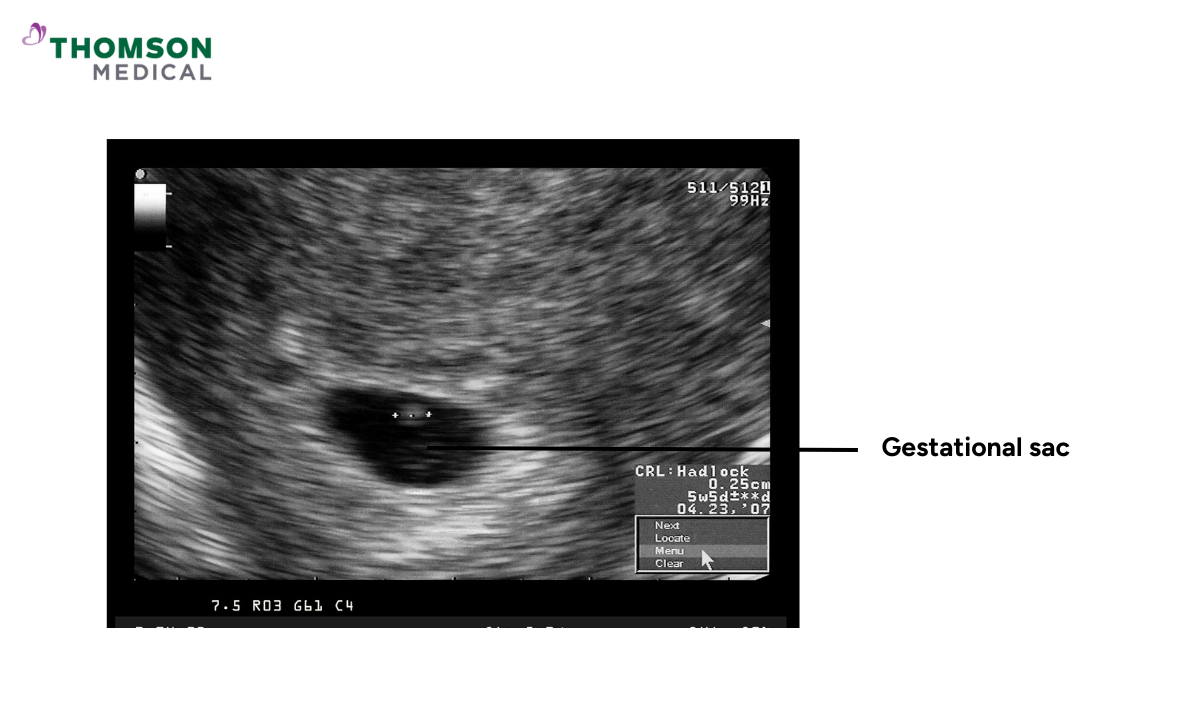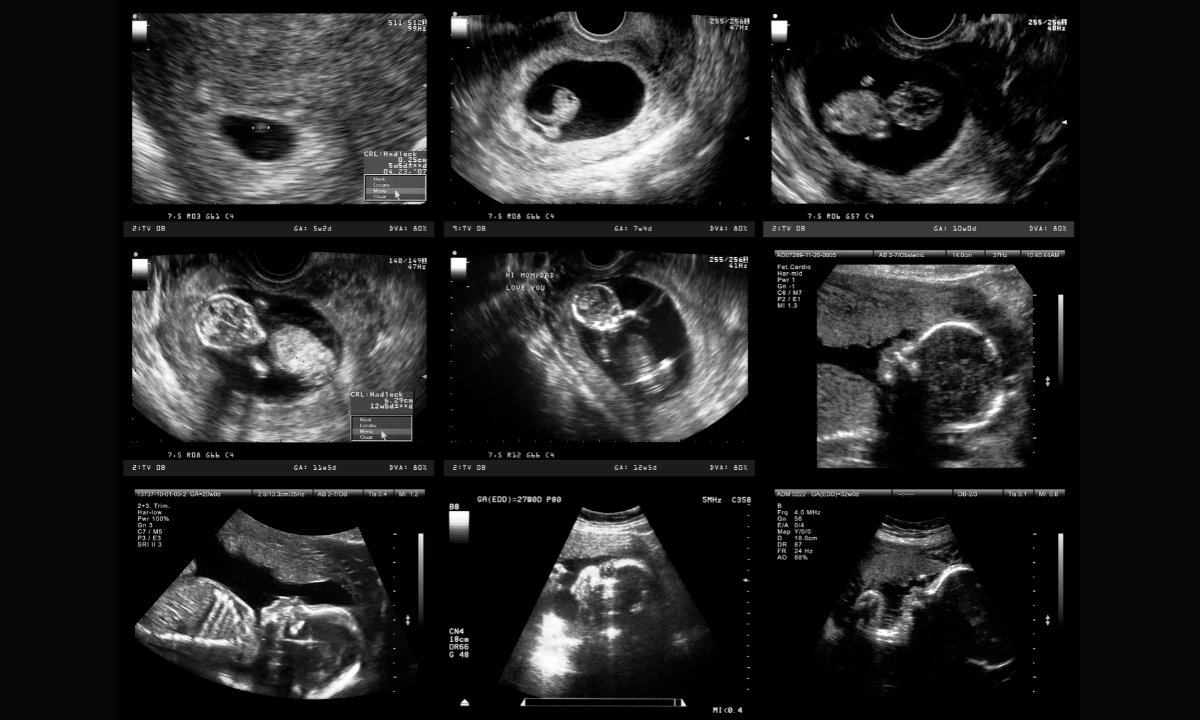When your pregnancy begins, your body will create new structures that exist only for this special time. They are not permanent organs like the heart or liver, but they play an important role in protecting the baby as it grows. The first of these to appear is the gestational sac.
On an ultrasound, the sac is often the earliest sign of pregnancy. It usually looks like a small circle with a thin outline. Although it looks simple, it is usually the very first visible sign of pregnancy and the first thing doctors look for in an early scan. Finding it inside the womb tells that the pregnancy is developing in the right place.
What is the gestational sac?

The gestational sac forms soon after a fertilised egg settles into the lining of the womb. It is filled with fluid as a protective space for the baby and its supporting structures can develop safely.
On an ultrasound scan, this space usually shows up as a dark rounded area. The dark represents fluid, while the thin white rim around it is the early placenta, known as the chorionic membrane.
The sac confirms that the pregnancy is developing inside your uterus. This helps rule out an ectopic pregnancy, which happens when the fertilised egg grows outside the womb, often in a fallopian tube. Ectopic pregnancies can be dangerous if not treated quickly, so seeing a gestational sac in the right place is always reassuring.
When does a gestational sac form?
The sac forms around 4 to 4.5 weeks after the last menstrual period. By this stage, many women may still be waiting for a positive test result or may have only just discovered they are pregnant.
The method of scanning matters too. With a transvaginal ultrasound, where a slim probe is gently inserted into your vagina, the gestational sac can often be seen as early as 4.5 to 5 weeks. This approach provides a much clearer picture in early pregnancy. With a transabdominal ultrasound, which uses a probe on your belly, the sac usually does not appear until 5.5 to 6 weeks.
Doctors will keep an eye on your pregnancy hormone called hCG (human chorionic gonadotropin). Once the level rises above about 1,500 to 2,000 mIU/mL, the gestational sac can usually be spotted on a transvaginal scan.
What are gestational sac, yolk sac and foetal pole?
The gestational sac is only the beginning. As the pregnancy develops, other structures appear in a clear order:
Gestational sac is the first sign, forming the protective space
Yolk sac forms between 5 and 5.5 weeks. It feeds the embryo and helps in the formation of its first blood cells. On ultrasound, it is visible as a little white ring inside the gestational sac
Foetal pole forms around 6 to 6.5 weeks as a thickening close to the yolk sac. This is the embryo's earliest stage
By 6.5 to 7 weeks, a heartbeat may be visible. That small flicker is often the most reassuring sign of all.
What happens if no gestational sac is seen on ultrasound?
Sometimes, a woman may have a positive pregnancy test, but the scan shows no gestational sac. Although this is worrying, it does not usually mean that something is wrong. Possible reasons include:
Too early in pregnancy: Ovulation may have occurred later than expected, making the pregnancy younger than estimated.
Ectopic pregnancy: If the pregnancy develops outside your womb, most often in a fallopian tube, a sac will not be visible in your uterus.
Miscarriage: A pregnancy that started but did not continue to develop may also explain the absence of a sac.
To clarify the situation, doctors often repeat hCG blood tests 48 hours apart to look for appropriate changes in hormone levels. A repeat scan after 5–7 days often provides clearer answers.
Our O&G specialists
Loading...
What does an empty gestational sac mean?
Occasionally, a gestational sac may be seen but appears empty, with no yolk sac or foetal pole inside. If this continues past 6.5 to 7 weeks, two explanations are possible:
Blighted ovum (anembryonic pregnancy):
The embryo either did not develop at all or stopped growing very early, even though the gestational sac continued to enlarge.
Later dates than expected:
The pregnancy may simply be earlier than first believed.
Because timing makes such a difference, doctors often wait and rescan before making a final diagnosis. Sometimes, what looked empty at first later shows normal growth.
What if the gestational sac looks irregular?
A healthy gestational sac is typically smooth, spherical, or oval, with firm, thick walls. Certain features, however, may cause concern:
An odd or collapsed shape
Extremely thin walls (less than 2 mm)
A yolk sac that is off-center
The sac wall wrinkles or folds
These findings can potentially indicate a miscarriage, inadequate implantation, or an atypical pregnancy. But not every irregular sac leads to loss. Regular monitoring is essential to see how things develop over time.
What if the yolk sac is missing or abnormal?
The yolk sac has a crucial role before the placenta takes over. It supplies nutrients to the embryo and helps in the formation of early blood cells. A typical yolk sac is smaller than 6 mm across and is a well-defined spherical.
Concerns may arise if:
It is not visible after 5.5-6 weeks may indicate a failed pregnancy
A yolk sac larger than 6 mm is linked to an increased risk of miscarriage
Malformed yolk sac can be associated with chromosomal issues or poor embryo growth
Remember, a single abnormal scan does not necessarily determine the outcome. Doctors watch closely with repeat ultrasounds before confirming outcomes.
If you have concerns about your scan or early pregnancy, it’s always best to speak with a healthcare professional. You can also request an appointment to get personalised advice and reassurance.
Can a gestational sac exist without a foetal pole?

Yes, and this is normal in very early pregnancy. The development usually follows this pattern:
Around 4.5 to 5 weeks
The gestational sac is visible on the scan.
Around 5 to 5.5 weeks:
The yolk sac appears within the gestational sac.
Around 6 to 7 weeks:
The foetal pole shows up, often followed by a tiny heartbeat.
Each step follows in order, which is why patience is often required in the earliest weeks.
FAQ
What does it mean when there is a gestational sac but no foetal pole?
It often means the pregnancy is still early. The foetal pole usually appears by 6 to 7 weeks. If it remains absent after 7 weeks with a normal sac size, the result may suggest a blighted ovum. Doctors usually arrange another scan and hCG testing before confirming.
Can you have a gestational sac without a foetus?
Yes. At the very start, the embryo may not yet be visible. The embryo in a blighted ovum either never develops or stops very early, but a gestational sac grows.
Can a gestational sac be hidden?
Occasionally. If the womb tilts backwards (a retroverted uterus) or the mother has a higher body mass index, the sac may be harder to see on an abdominal scan. In such cases, a transvaginal ultrasound gives clearer images.
What if hCG levels are high but no foetal pole is seen?
This can point to an ectopic pregnancy or a blighted ovum, but it may also simply mean ovulation occurred later than thought. Doctors usually repeat hCG blood tests and schedule follow-up scans to confirm.
How late can a foetal pole develop?
Normally the foetal pole is visible by 6 to 6.5 weeks. In some pregnancies, particularly if ovulation was late, it may not appear until 7 to 7.5 weeks.
What are the symptoms of an empty gestational sac?
Often, there are no symptoms at all. Some women may notice light bleeding, mild cramping, or a sudden fading of pregnancy symptoms like nausea or tender breasts. Ultrasound is the only way to confirm.
The information provided is intended for general guidance only and should not be considered medical advice. For personalised recommendations and tailored advice based on your unique situations, please consult a specialist at Thomson Medical. Request an appointment with Thomson Medical today.
For more information, contact us:
Thomson Specialists (Women's Health)
Thomson Women's Clinic (TWC)
- Novena:
6592 6686 (Call), 8611 8986 (WA) - Bukit Batok:
6569 0668 (Call), 8686 3525 (WA) - Choa Chu Kang:
6893 1227 (Call), 8282 1796 (WA) Jurong:
6262 8588 (Call), 6262 8588 (WA)- Katong (female doctor):
6970 2272 (Call), 8611 9020 (WA) - Punggol:
6243 6843 (Call), 8811 0328 (WA) - Sembawang: 6753 5228
- Sengkang: 6388 8125
- Serangoon (female doctor): 6382 3313
- Tampines: 6857 6266
- Tiong Bahru: 6276 1525
